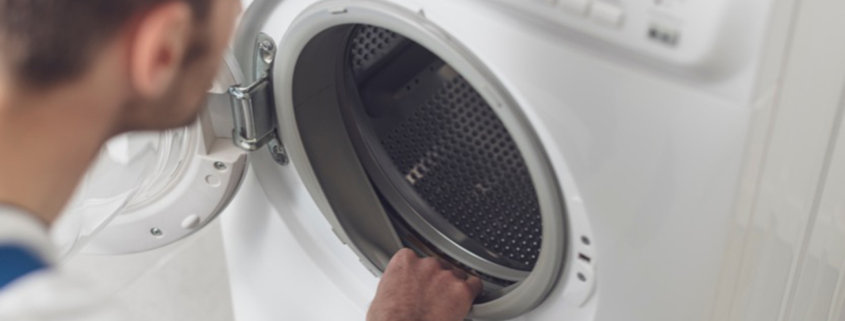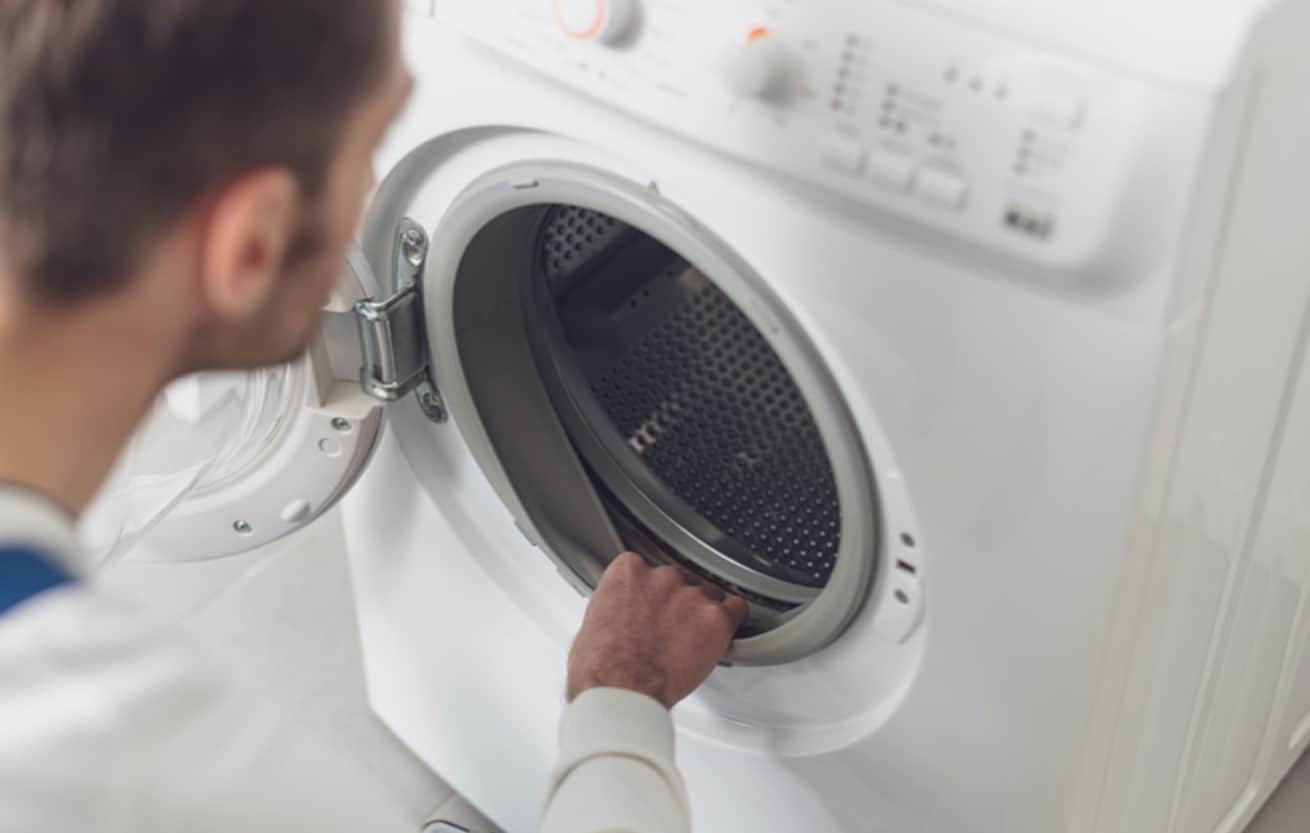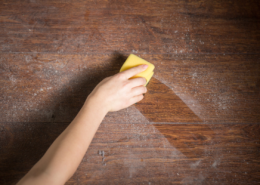How to Deep Clean a Washing Machine—Top and Front Loading (and Why You Should!)
If you assume the inside of your washer is the cleanest place in your home because you put detergent through it with every load of laundry, join the club. And that’s a really bad assumption. It’s time for us to learn how to clean a washing machine.
Have you ever wondered why there’s dirty residue on the agitator? Why do washed clothes sometimes come out with stains they didn’t have before they went in? Why do towels get stinky? Why you open the lid of the machine and get a waft of stink?
The answer is germs. According to a study by Dr. Charles Gerba, professor of microbiology at the University of Arizona, if you wash a load of just underwear, there will be 100 million E. coli in the wash water, which can be transmitted to the next load of laundry.
However, this is good to know—of the more than 60,000 germs, only one to two percent of them are potentially pathogenic. But the other 98 percent, when allowed to accumulate, can produce a terrible odor in clothes, towels, and linens—and inside the washer, too.
If you rely on laundry detergent alone to get rid of all the dirt and germs but are not occasionally using bleach and very hot water, you’re not killing the bacteria. In fact, they’re getting on your hands when you remove the wet laundry and also staying behind in the washing machine.
How to Clean a Washing Machine
You’ll need:
✅ rubber or latex gloves
✅ cleaning cloths
✅ old towels
✅ bucket or container for mixing
✅ plain white vinegar
✅ liquid chlorine bleach*
✅ hot water
If possible, turn up your water heater to at least 140 F. several hours before you clean your washer.
CAUTION
Professionals recommend keeping your water heater set at a temperature between 130 and 140 degrees Fahrenheit. Any higher or lower could be dangerous for you and your family.
While turning the temperature up higher can result in burns, turning it lower than the recommended setting can also be dangerous. In colder water temperatures, bacteria can form in the water heater tank. This could become a health risk for you and your family, potentially exposing you to health hazards such as Legionnaires’ disease.
This illness is a type of pneumonia and the bacteria that causes the illness can thrive in a water tank between the temperatures of 77 degrees and 113 degrees Fahrenheit.
Read the manual
Washing machine manufacturers almost always include a cleaning directive in the owner manual. My 9-year old GE front loader has a setting on the dial for “Clean Basket,” as do many newer washers. Start following the directions in your owner manual if you have such a setting. Or these general instructions:
Front-Loading Washing Machine
This is a multi-step process, which should be performed monthly.
- Make sure the drum of the machine is completely empty—never include any items of clothes, towels or other while cleaning the machine. Select “Basket Clean” or “Tub Clean” on the wash settings. Select the hottest, largest, and longest load settings if your front loader does not have such a setting.
- Add 2 cups of white vinegar to the empty washer drum (or to the detergent reservoir if your machine does not have a “Basket Clean” or “Tub Clean” cycle). This will help eliminate the odors and any mildew that has accumulated inside the machine. Allow the machine to run through an entire wash and rinse cycle.
- Set the washer a second time on the same cycles as above—“Tub Clean,” or “Basket Clean,” or the hottest, largest and longest cycles. Pour 2 cups of liquid chlorine bleach into the empty washer drum. This is going to kill germs and bacteria that have accumulated inside the machine. Allow the machine to run through another entire wash and rinse cycle.
- Run a third cycle on the same cycle without adding anything to the empty washer drum. This will remove and rinse away any remaining residue.
- Fill a bucket with a solution of 1/4 cup liquid chlorine bleach and 1-quart water. Dip a clean rag into the solution, ring it out. Pull back the rubber seal around the washer door, looking for mildew and other deposits. Clean this area well with the rag or scrub brush, rinsing it as needed in the bucket. Follow with a clean, dry cloth to remove any remaining moisture from the seal area.
CAUTION
Never mix bleach and vinegar. Ever. Together they produce harmful toxic gas. The cleaning process above provides for these substances to go into the machine separately, followed by complete rinse cycles to clean out the reservoirs.
Top-Loading Washing Machine
This process is similar to cleaning a front-loading machine and should be repeated monthly.
- Making sure there are no clothes in the machine, set it to the hottest, largest, and longest cycle available. Add 4 cups (1 quart) of plain white vinegar to the tub (no detergent). Close the lid and allow the machine to agitate for one minute or so. Open the lid (or press “Pause”) so agitation stops and allow the machine to sit for one hour. After one hour, allow the machine to complete a full cycle including rinse and spin.
- Leaving the same settings, fill the machine with the hottest water available and add 4 cups (1 quart) liquid chlorine bleach. Close the lid and allow to agitate for one minute, then open the lid to stop the agitation for one hour.
- After one hour, allow the machine to complete a full cycle including rinse and spin, again.
- Run a third cycle on the same settings without adding anything to the detergent reservoir. This will rinse away any remaining residue.
- Finally, using a clean cloth dipped into a mixture of 1/4 cup liquid chlorine bleach to 1-quart water, clean the area under the rim of the washer—between the basket and machine’s housing. Wipe down the detergent reservoir and clean all of the nooks and crannies of the washer that you can reach easily, where bacteria and dirt may have accumulated.
*If you don’t want to use chlorine bleach, do not assume that oxygen-based bleaches or hydrogen peroxide will give you adequate disinfectant qualities needed for cleaning. PineSol in place of liquid chlorine bleach is an acceptable and effective substitute to clean your washer. And it is septic system safe. Follow the same steps for cleaning with chlorine bleach as listed above.
More
- Dingy Gray Laundry is the Problem—This is the Solution!
- How to Make the Best Homemade Liquid Laundry Detergent
- A Simple Solution for Gross, Smelly Towels
Published: 2-28-20; Updated 11-30-22
















Years ago I read somewhere to always leave your front loader open for at least one-half hour after the last load so it can dry. If I do this everytime, it never smells. You still have to clean it but no smelly machine in-between cleans!
We cannot confirm that, Robin.
Thanks so much for these instructions. My front loading washer really needs to be cleaned and I knew you had posted on this before. I was going to look up what you had said before and was blessed when you posted again today.
For years we had an “old school” top loader washing machine which finally broke down last year. Since nobody at our house really wanted to do laundry, I was assigned the task of getting us a new washing machine. I got us a LG-WM4000 washing machine. My family was horrified at my choice and basically assigned me the task do doing the laundry since they didn’t want to mess with a front loader. (I think it was really just an easy excuse to assign me the task of doing the laundry!) I now do the laundry for a family of 4, which includes myself and 3 females. My machine does not has one spec of mold that I can see and smells great. Here is my protocol for keeping it clean.
1. I very rarely use fabric softener, and NEVER at full strength, none at all if I can get away with it. Sometimes, a family member begs and pleads for her beloved Downey. Fine, I used to grudgingly give her one (and only one) capful of her petroleum based carcinogenic liquid wax. But for the last two months what they don’t know is that I’ve poured out that Downey and flushed it down the toilet. What’s actually now in the Downey bottle is now a plant based biodegradable natural fabric softener and even that I have diluted by about 25% with water.
2. If the load has clothes in it (its not a “Tub Clean” or just a spin cycle) I add a scoop of Borax in the tub along with the clothes.
Borax (sodium borate) is slightly stronger than baking soda. With a pH level above 9, borax creates an unfavorable, high-alkalinity environment that kills mold and inhibits it from regrowing. It’s weaker than ammonia, but it’s a natural product and doesn’t produce harmful fumes. The water which is left on the rubble seal now has Borox in it, probably not enough on its own to 100% prevent mold, but probably enough to help slow it down between tub cleans.
3. I always run the “Tub Clean” every 20 or so loads. (LG recommends 30 loads, but in my opinion that’s too many.) Whenever I run “Tub Clean” I use “Washing Machine Cleaner Descaler 24 Pack – Deep Cleaning Tablets For HE Front Loader & Top Load Washer” by “ACTIVE”. (Not an advertisement, use whatever cleaner you want. I use this brand because a YouTube washing machine repair guy recommends it.) You can get it on Amazon.
4. After the last cycle of the day (which is usually around 2:00), I wipe the gasket with a dry towel, make sure to spread the lips of the gasket and also dry the inner surface, all the way around. I also leave the door slightly open when done and also leave the dispenser tray open. Sometimes I even remove the dispenser tray from the machine, turn it upside down and let it dry until next time I wash.
5. Around 10:00 at night before I go to bed, I re-wipe the door boot seal and then run my finger through the lips of it to make sure it is dry. It takes roughly 24 hours for mold spores to grow. If the seal has mold on it, that means I had 24 hours to get it dry and I failed!
6. No bleach, sorry, unless I’m cleaning the drain pipe. To the best of my information, bleach will damage the rubber seals, and that damage MAY begin in as little as 10 minutes.
7. No vinegar, sorry. To the best of my information, vinegar will damage the rubber seals, although I have not been able to find out how long it takes to do so.
8. After every 50 loads, I drain the machine, using that small door on the bottom left and clean the filter. It seems like I am the only person other than washing machine repair men who do this. I have never met another person who does this, even though the manual says to do so every 30 days! The point is though, stagnant water is a good place for bacteria to grow and make the machine stink. I also take this time to remove the drain hose from the drain pipe and wipe the end of it with bleach. The end of that pipe is loaded with bacteria.
They now call me “The Washing Machine Nazi”, but they also admit the wash is noticeably cleaner than it was with the old top loader. They just complain the towels don’t have that fabric softener smell. I tell them to get some essential oil and spray on them.
Can Pinesol be used in the front loaders instead of bleach?? Thank you.
Yes.
How can you remove the Pinesol odor?
How can you remove the Pinesol odor once the washer is clean?
You could run a cycle or two using the hottest water available. It will soon dissipate.